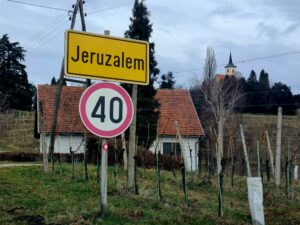When she died on her thirteenth birthday on St Patrick’s Day in 1887, Hungary mourned its loss. The nation’s flags flew at half-mast and Hungarians knew they would never see the like of her again. All around the world, those who knew her and knew of her, realised how truly amazing she had been.
Kincsem was probably the most successful thoroughbred racehorse ever, winning all 54 races she started in. While she later became the toast of Europe, there was a time when she was passed over because she was too common looking. Legend has it that she went missing from home one night. She’d been running with 49 other horses on her owner’s estate and was by far the most ungainly. She turned up later with a band of gypsies. When her owner asked why they’d chosen Kincsem above the others, he was told that although the other horses might be better looking, she was the one who would be the champion. And she was. She won fifty-four races in five countries and was never defeated.
Kincsem was sired in Kisbér – a small town in northwestern Hungary that was once home to the Hungarian National Riding School. She was bred by Ernest de Blascovich, a young man in his 20s whose horses went on to achieve great things. The town’s horse breeding history kicked off in 1830, when the Battyány family started breeding imported English thoroughbreds and later established a military stud farm that was to become state property. The old Battyány home was used till recently as a hospital and now stands empty.
The buildings are now historic monuments, the largest of which is the recently renovated Royal riding hall, originally built in 1859 and in its day one of the largest covered riding schools in Europe. Sadly, it sits empty at the centre of what is called Ménesbirtok (stud farm) but is really a group of buildings that are crying out for a developer to continue developing.
Millions of EU funding has already been spent and yet there’s an air of desertedness about the place. Yes, it was a Sunday afternoon in November, but what better time to visit a museum? A search of the Net yielded little so while the converted stalls are labelled Kincsem souvenirs, Huszar museum, etc., I found myself wondering what exactly lay behind those closed doors. White elephants perhaps?
I’m a great fan of racing and like few things better than to while away an afternoon at the races. I grew up in Co. Kildare, home of the Irish National Stud, a county where racing is very much a part of life. I still have hopes of one day owning at least a leg of horse and feeling the pride that goes with entrance to the winners’ enclosure.
I’d also like to go back to Kisbér to see the museum so if anyone has any details about opening times / events, please let me know.
Share this:
- Click to share on Twitter (Opens in new window)
- Click to share on Facebook (Opens in new window)
- Click to share on Pinterest (Opens in new window)
- Click to share on LinkedIn (Opens in new window)
- Click to share on Reddit (Opens in new window)
- Click to share on WhatsApp (Opens in new window)
- Click to share on Pocket (Opens in new window)
- Click to share on Telegram (Opens in new window)
- Click to email a link to a friend (Opens in new window)









2 Responses
A beautifully repaired and conserved building, if it is empty and without a use, in many ways remains derelict. Buildings need a use; for what, can be less important, than that they are.
I don’t suppose you watch Hungarian TV, but there was a half-hour programme about Kincsem on Tuesday evening, with many pictures of Kisbér. But it didn’t give the details you require – sorry!